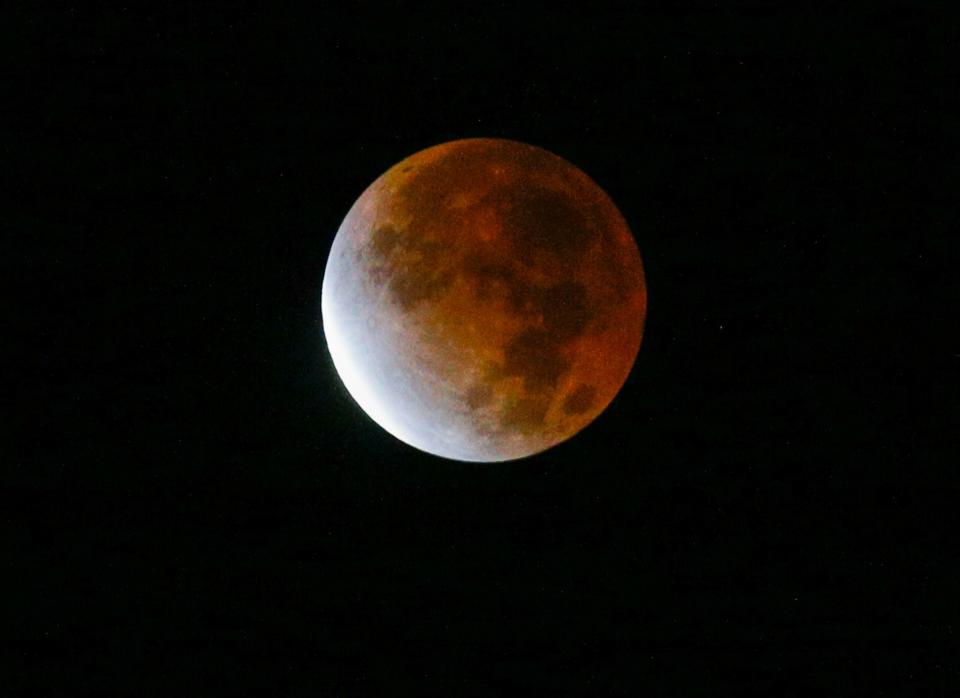Everything you need to know about 'super flower blood moon' lunar eclipse coming Sunday
Those who are up late Sunday night may be able to catch a spectacle in the sky with a very long name — a so-called "super flower blood moon" lunar eclipse.
During this astrological event, which will begin Sunday night and carry on into the wee hours of Monday morning, the moon will receive only sunlight bent through the Earth's atmosphere and will change color over the minutes, from gray to pink to orange to red, according to USA Today.
Under ideal weather conditions, the eclipse will be visible from portions of the Americas — including Greater Columbus — as well as Europe, Africa, Antarctica and the east Pacific.
Astronomy: A column about The Beginning, and an end
Eight 'Wonders of the World': Ohio History Center features display of ancient earthworks
But we all know that weather in central Ohio isn't always ideal, and, well, there just might be some clouds and rain in the forecast.
If you miss this one, at least another eclipse is coming later this year. The next one will occur Nov. 8, according to Space.com.

What is a lunar eclipse?
Total lunar eclipses happen when the whole moon passes through the innermost part of Earth's shadow, which is called the umbra, according to Space.com.
During the event, the Earth blocks all direct sunlight from reaching the lunar surface, with sunlight instead scattered by Earth's atmosphere and reflected off the moon's surface. This type of lunar eclipse gives the moon its red hue.
What is a blood moon?
During a total lunar eclipse, a blood moon occurs, making it look red. This is due to light from Earth's sunrises and sunsets falling on the surface of the moon. Because the light waves are stretched out, they look red. When this red light strikes the moon's surface, it also appears red.
What is a supermoon?
According to Space.com, a supermoon occurs when the full moon coincides with the moon's closest approach to Earth in its orbit. The reason why supermoons only happen a few times a year is because the moon's orbit changes orientation while the Earth orbits the sun.
The moon will appear as much as 30% brighter and 14% larger than normal, but it's difficult for the casual observer to notice the difference.
What is a flower moon?
Sunday's event is called the "flower" moon, as it is a name given to May's full moon. This is because "flowers spring forth across North America in abundance this month," the Old Farmer's Almanac said.
The full moon names used by the almanac come from a number of places, including Native American, Colonial American and European sources. Traditionally, each full moon name was applied to the entire lunar month in which it occurred, not solely to the full moon.
What time will the lunar eclipse be visible?
The eclipse is expected to begin at 10:28 p.m. Sunday and continue until 1:55 a.m. Monday. The blood moon portion of the event is expected to start at 12:11 a.m, according to Space.com.
However, there may be a chance folks in Greater Columbus will not be able to see the eclipse. Cloudy skies and a 60% chance of showers is in the forecast Sunday night, said Andy Hatzos, a meteorologist for the National Weather Service in Wilmington.
Support local journalism. Subscribe to the Dispatch today to access all of our content online at www.dispatch.com/subscribenow/.
"This is Sunday ... that's a long way out, so the forecast will have a tendency to change between now and then," he said.
Temperature-wise, the night will have a low of 56 degrees.
How will I be able to see it?
Unlike a solar eclipse, special glasses aren't needed to see a lunar eclipse.
Space.com recommends heading outside at least 20 minutes before the eclipse starts so that people's eyes can get adjusted to the darkness. Equipment such as cameras, telescopes and binoculars may need a few hours to adjust to the different temperatures and humidity outside, so bring them out as soon as possible to avoid issues with dew.
Also, keep bright phones or flashlights off to maximize the experience of the eclipse.
USA Today reporter Doyle Rice contributed to this article.
Micah Walker is the Dispatch trending reporter. Reach her at mwalker@dispatch.com or 740-251-7199. Follow her on Twitter @micah_walker701.
This article originally appeared on The Columbus Dispatch: What to know about 'super flower blood moon' lunar eclipse Sunday

